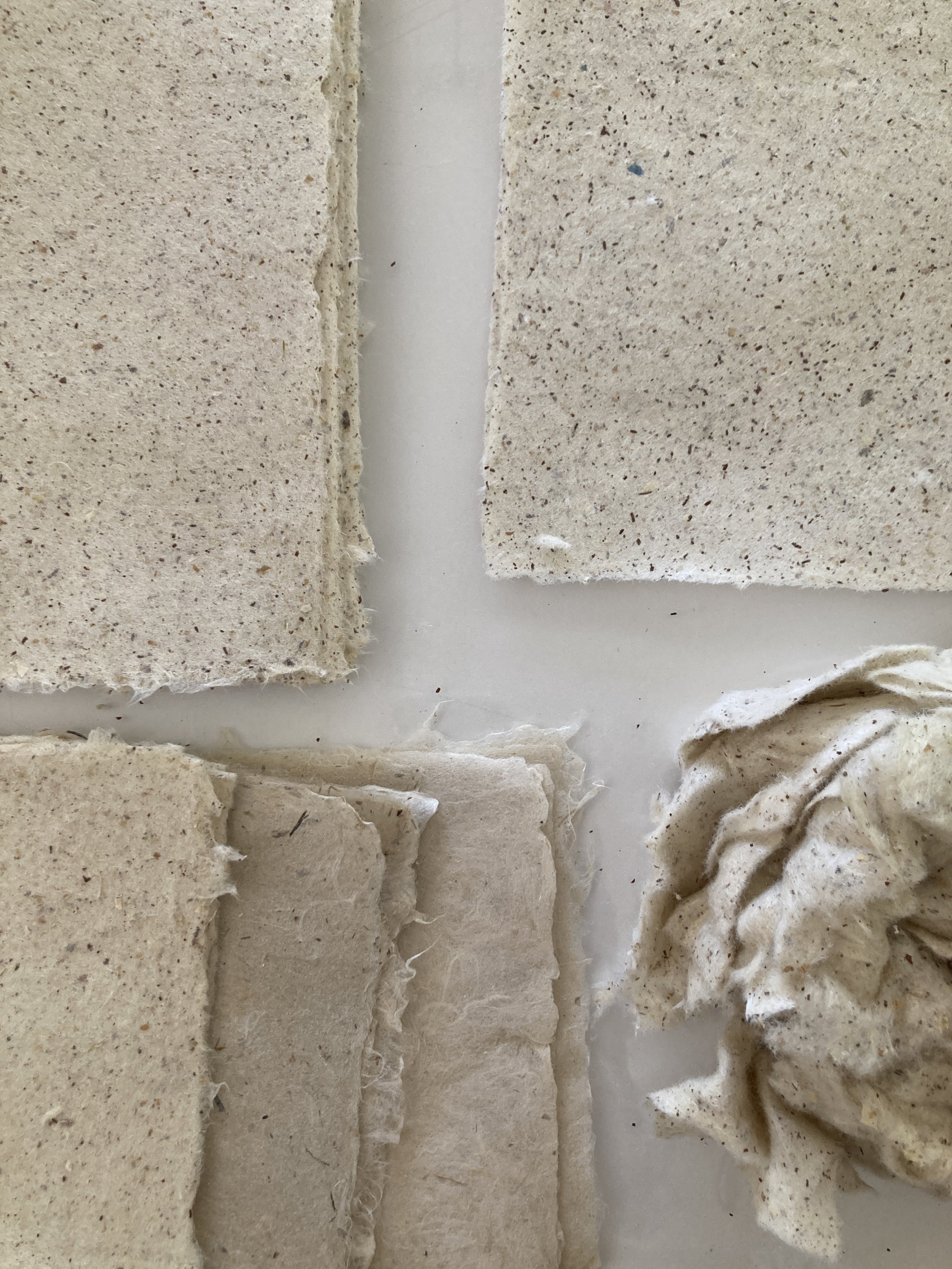It was incredibly fulfilling to process the milkweed into pulp and then form it into sheets, though I tried to hold it all loosely and not get too attached to any expected results. The beautiful milkweed floss that we processed in the beater and formed into sheets on Sunday, completely fell apart upon unloading from the dry box, each soft spongy sheet easily broken. It was basically fluff compressed into the form of a sheet, ready to turn back into a cloud, forcing me to indeed, hold it loosely:
Various milkweed paper samples. The ball of crumpled paper on the bottom right is milkweed floss paper that wanted so badly to go back to being soft and fluffy
Although Aimee says in her zine that cooking the fluff is not required, I thought that maybe even a light cook would somehow help keep the sheets from falling apart. I also thought maybe I didn't beat it well or long enough, so I also tried to re-beat some of the fluff that had been soaking for a couple days. Re-beating the fluff proved quite difficult; I could tell the beater was struggling and the buoyancy was out of control. I had to really push the fiber along manually, otherwise it would not circulate. I gave up and tried making sheets with the uncooked and "rebeaten" fluff anyway; results were similar to the first batch but perhaps slightly less fragile.
Super buoyant milkweed floss very slowly moving through the beater
I had better luck with the cooked fluff pulp, which I cooked with a tiny bit of soda ash (~3 or 4%). I pulled some sheets with the cooked pulp, and also tried re-beating it and then pulling sheets. Results between the two were similar, leading me to believe that somehow the cooking is what helped.
Descriptions from Aimee's zine and images of the rattly, translucent paper coming out of Atelier de Papier make me wonder why my results were so... the opposite of rattly and translucent. The milkweed fluff sheets that I made were, at best, still soft and a bit spongy. I had the best results from mixing in a bit of the bast fiber with the fluff pulp, which gave the sheets a bit more stability. I'm wondering if the presence of so much extraneous plant matter (like bits of seeds and cores) somehow changed the nature of the finished sheets, or if it has something to do with how “fresh” the floss is - when it comes right out of the pod, it’s so silky, but when it’s been sitting in piles outside for weeks, it turns more fluffy and behaves more like cotton. This is just pure observation and I have no scientific backing to explain how the material transforms even before processing, causing the resulting paper to be totally different. I honestly don’t know.
A pressed, wet sheet of milkweed fluff paper before loading it into the dry box
The bast fiber, on the other hand, was a dream to work with. I knew after making the little test sheets on Sunday that I wanted to try to make larger webal sheets from the stalks. I cleared out my schedule for Tuesday morning. Thanks to my kids' school schedule, I was up and ready to work by 7:30am and had pretty much exhausted the vat and cleaned everything up by noon. It still fills me with so much wonder and gratitude that I am able to make webal hanji in my own backyard. I often feel the urge to invite people over when I make webal hanji since it is so rare and special. But this time I needed to be alone, I needed a sacred space and receive it as a gift, for me. (Plus, who would be available on a random Tuesday morning…probably no one)
Scraped milkweed stalk pulp
I wrote in my journal the next day: "I wake up thinking about the paper." Some images of webal milkweed hanji, from sheetforming to parting to drying to finished sheet (notice the difference in color between scraped and unscraped milkweed fibers):
A week later I was fortunate to return to my alma mater UICB and make some prints on the milkweed paper I had made. These prints are special, they are studies of folded paper maps, which I will one day turn into little books. I rarely get to develop and execute finished works, I feel like I am percolating and testing new ideas, teaching, sharing, making quick studies then moving on to the next thing. These days I am more interested in making spaces of discovery, community, collaboration, and connection through plants and cultural heritage and craft. Whether or not it results in a finished product feels besides the point, and miraculous when it does happen. In the meantime, I'm letting most of these prints sit in a flat file until they are ready to be folded into books someday.
image on left is printed on dak hanji I made a few years ago; image on right is printed on milkweed hanji I made the week before
A proof print on “mystery dak hanji” (mysterious dak that I found in my fridge and threw into the webal vat and formed into sheets) dyed with persimmon juice. These prints are meant to be folded up into little pocket maps, inspired by ancient Korean maps of the universe. Someday I will edition these… someday…
















